Although you probably think of Chicago when you think of Illinois, hearing that the Prairie State has more farmland and prairies than cities may surprise you. But it’s true!
According to the Illinois Department of Natural Resources, there are 40 native snake species. That’s right, all that open prairie and farmland gives these slithering rodent assassins plenty of room to roam.
Fortunately, only four are venomous and aren’t very common. However, we’ll make sure you can identify venomous snakes too.
Which snakes are you most likely to find in your garden? Let’s find out the most common Illinois garden snakes.
The Most Common Illinois Garden Snakes
There are several snakes that call Illinois home. Being able to identify them is important so let’s dig into the snakes you are likely to see in the state.
Eastern Garter Snake (Thamnophis sirtalis sirtalis)

Garter snakes are one of the most common Illinois garden snakes.
©Erik Agar/Shutterstock.com
One of the most widespread snake species in North America is the garter snake. Garter snakes occupy any area with their favorite prey: frogs, salamanders, and small invertebrates. Most garter snakes enjoy more humid habitats with a water body nearby, but a few are more terrestrial.
Eastern garter snakes are thin and rarely grow longer than four feet long. They’re easy to identify by three stripes that run the length of their bodies. This species comes in many colors, but most are brown, black, or green with yellow stripes.
For many years, scientists believed garter snakes were nonvenomous because no one has ever suffered a severe reaction to a garter snake bite. That changed several years ago when they discovered that garter snakes have enlarged rear teeth and very mild venom. But, because the venom is prey-specific, it’s never done any lasting harm to people.
While they’re not aggressive, garter snakes are highly defensive. Garter snakes’ primary defense is musk — a disgusting-smelling fluid they release when they feel threatened. Some people call them “stinky snakes.”
You can usually find eastern garter snakes near a water source throughout Illinois. They also hide under moist leaf litter, rocks, rotten logs, and other covers. Because they’re more cold-tolerant than other snakes, you’ll even see them basking on a warm winter day.
Other garter snakes in Illinois Gardens
Eastern garter snakes aren’t the only garter snake species in Illinois. There are more! One is an eastern garter snake subspecies that only lives in the northeast corner of the state — the Chicago garter snake (Thamnophis sirtalis semifasciatus). But the other is a separate species: the plains garter snake (Thamnophis radix).
Chicago garter snakes are similar to eastern garter snakes, except that their side stripes aren’t stripes — they’re broken by black bars, which look a lot like the dotted lines painted on the road.
On the other hand, the plains garter snake (Thamnophis radix) occurs in the northern part of Illinois. Some people believe that eastern garter snakes and plains garter snakes sometimes hybridize, but no one knows for sure.
Plains garter snakes have a yellow or orange dorsal stripe flanked by two green or yellow lateral (or side) stripes. They also have light yellow spots on top of their heads and black vertical bars on their lips.
Dekay’s Brown Snake (Storeria dekayi)
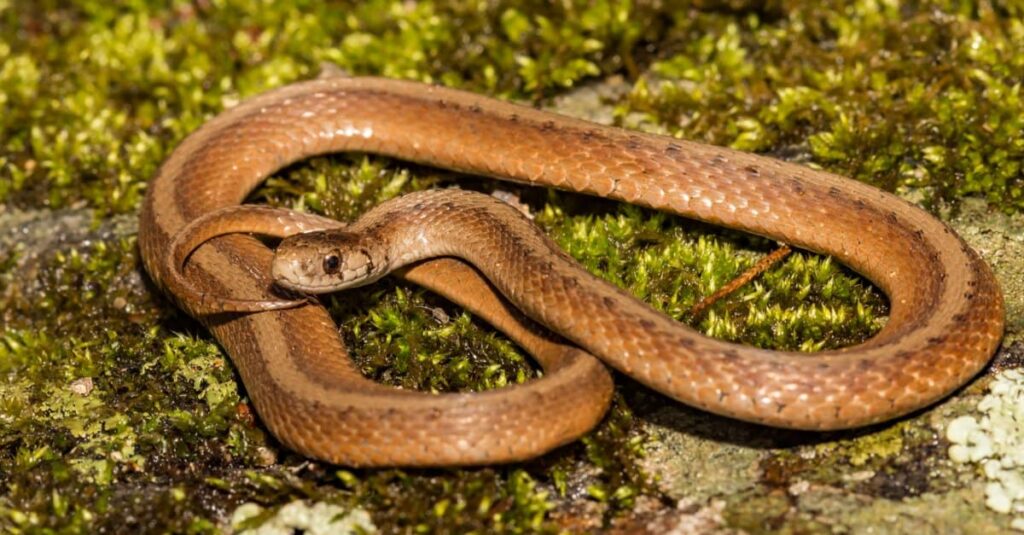
De Kay’s brown snake occupies most of Illinois and is not venomous.
©Jay Ondreicka/Shutterstock.com
The only North American snake named after not one, but two people in its binomial scientific name, Dekay’s brown snake’s scientific name is Storeria dekayi and honors James Ellsworth De Kay and David Humphreys Storer.
This snake is common in the eastern half of the U.S., but so shy and small that most people never see it. Adults rarely measure more than 12 inches long and are harmless unless you’re a slug, snail, or earthworm.
Slender and nonvenomous, Dekay’s brown snake varies from gray to brown with a lighter dorsal stripe. On either side of its dorsal stripe are small black spots.
Dekay’s brown snake is docile and almost never bites. Even if it tried to bite you, it can’t hurt you. A widespread garden helper, this snake occupies most of Illinois. You’ll find it hiding in leaf litter, garden beds, and even underground at times.
Northern Watersnake (Nerodia sipedon)
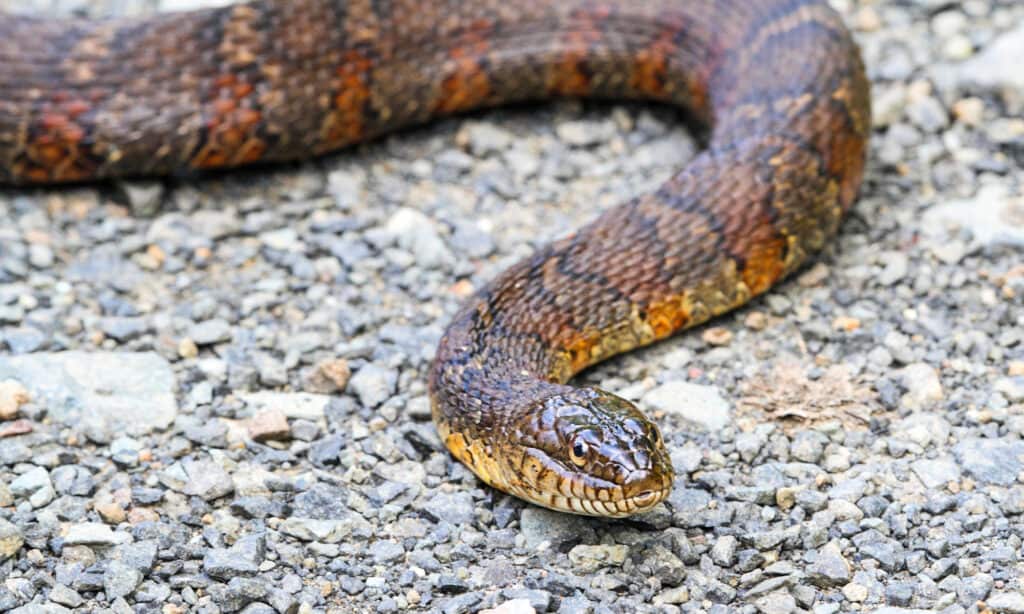
Northern water snakes are not venomous and are widespread throughout Illinois.
©Steve Byland/Shutterstock.com
Adult northern watersnakes may sometimes look like water moccasins or cottonmouths, but they are not venomous. Northern watersnakes are widespread across Illinois. The species grows to about three to four feet long with thick bodies.
Northern watersnakes are reddish, gray, brown, or brownish-black with dark crossbands on the neck that morph into blotches on the rest of their bodies. As they mature, the snakes darken and some turn almost black.
Semiaquatic and water-loving, northern watersnakes spend most of their time in and around water bodies. They eat fish, frogs, tadpoles, small turtles, and anything else they can grab.
One thing about northern watersnakes: beware of their teeth. They’re not venomous, but northern watersnakes think that the world is out to get them. So, if you pick one up for any reason, it will bite like its life depends on it because the snake really believes that it does! Because they eat a lot of aquatic animals, they have razor-sharp teeth that help them grab and hold on. Apply those teeth to your skin and you can easily see the problem — they’ll leave multiple marks.
Gray Ratsnake (Pantherophis spiloides)

Gray rat snakes are snakes that like to climb trees and rafters.
©Gabbie Berry/Shutterstock.com
The next snake you might find in your garden also likes climbing trees and garage rafters. Some rat snakes even surprise people in kitchens!
Like other rat snakes, gray rat snakes, are terrific climbers. They actively hunt small rodents, birds, bird eggs, and anything they can fit in their mouths.
Gray rat snakes are light gray with darker gray or brownish blotches on their backs. They’re one of the few rat snakes that don’t darken to black in most of their range. However, in northern regions, they can get as dark as eastern rat snakes.
They grow as long as six feet, but most are between four and six feet long. You’ll find gray rat snakes active during the day until the summer weather gets too hot. Then, gray rat snakes switch over to a crepuscular (morning and evening) schedule. It allows them to maintain their body temperature while still seeking out small mammals to eat.
Other Illinois Garden Snakes
Since Illinois has 40 species, the most common nonvenomous snakes we cover here only scratch the surface. There are several native king snakes, two hognose snake species, and two ribbon snakes. Here are a few more you may encounter:
- Plain-bellied watersnake (Nerodia erythrogaster)
- Eastern fox snake (Pantherophis vulpinus)
- North American Racer (Coluber constrictor)
- Rough green snake (Opheodrys aestivus)
- Ring-necked snake (Diadophis punctatus)
- Eastern milk snake (Lampropeltis triangulum)
Venomous Snakes in Illinois Gardens
Illinois doesn’t have many venomous snakes. What few live in the state are mostly restricted to the southern half or in isolated pockets.
All the venomous danger noodles in the state are pit vipers in the subfamily Crotalinae. They have loreal pits which are heat-sensing pits between their nostrils and eyes. Pit vipers have a few things in common:
- Long, hollow, folding fangs attached to large venom glands
- Large, triangular, or spade-shaped head
- Heavily keeled scales
- Vertical pupils that look like a cat’s eye
None of these snakes are common in Illinois. However, knowing how to identify them helps keep you and your pets safe from dangerous snake bites.
Massasauga (Sistrurus catenatus)
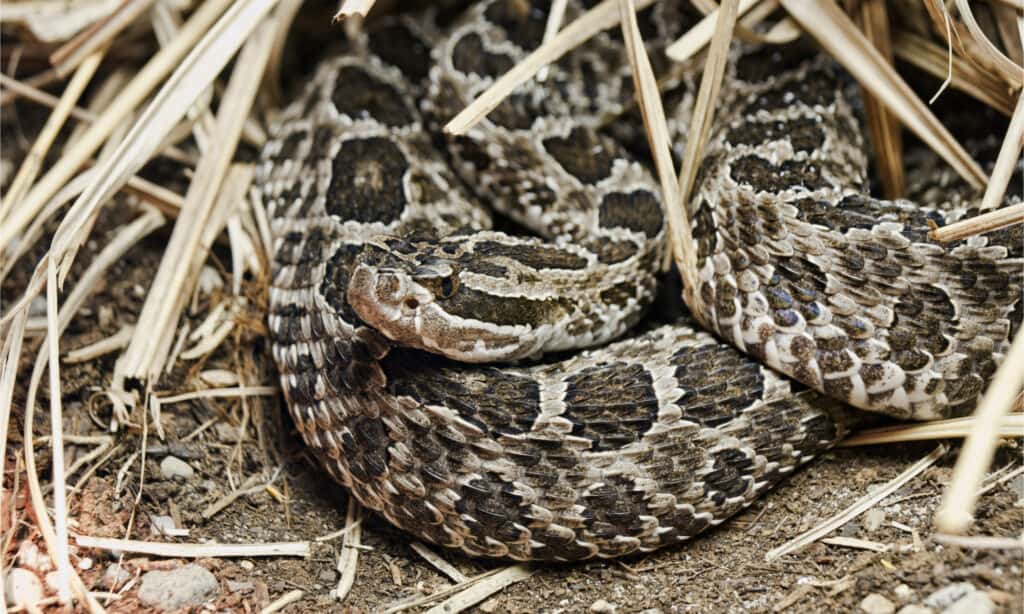
Massaugas only occur in the northern 2/3 of Illinois.
©DnDavis/Shutterstock.com
One of the smallest rattlesnakes, people often mistake the massasauga for a juvenile of some other rattlesnake species because of its size. The largest adult massasauga only measures about 30 inches — less than three feet long!
This species is light gray with dark blotches and a dark post-ocular stripe. The massasauga isn’t as heavily-built as other rattlesnakes, but still has a thick-for-its-size body that ends in a rattle.
You’re most likely to encounter a massasauga in the northern 2/3 of Illinois. It enjoys bogs, wet prairies, old fields, and other areas that provide the cover it needs. It’s mostly diurnal but becomes nocturnal during the hot summer months. This snake tends to shun human habitats and isn’t common near homes and towns.
Timber Rattlesnake (Crotalus horridus)
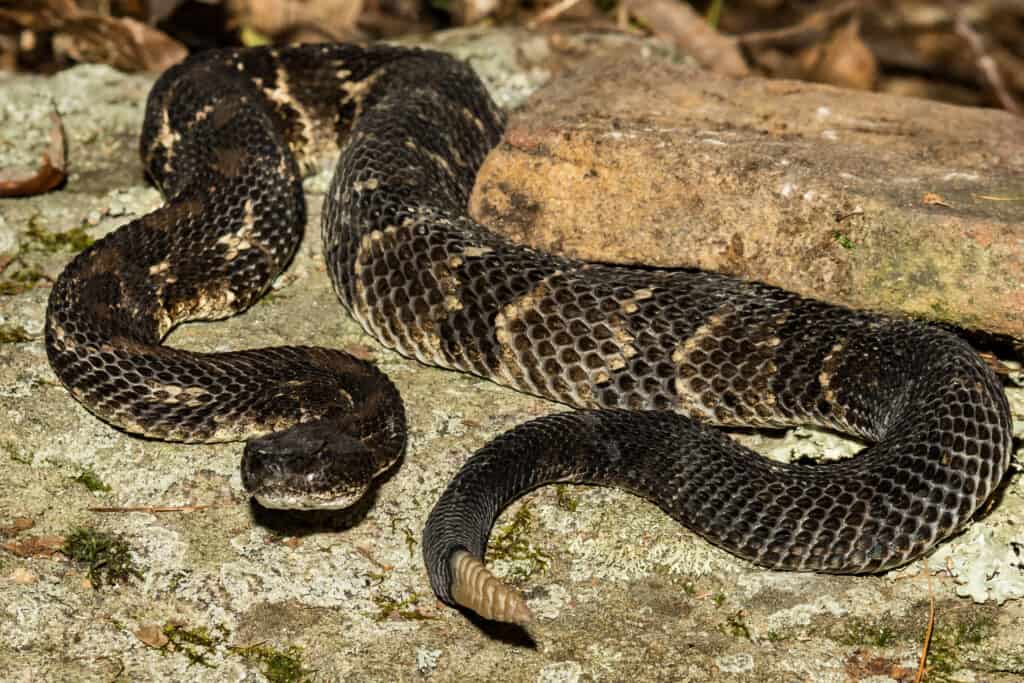
Timber rattlesnakes only occur in the southern 1/3 of Illinois.
©iStock.com/JasonOndreicka
Also rare, timber rattlesnakes only occur in the southern 1/3 of Illinois. They’re not aggressive and won’t bite without being stepped on or harassed. However, if they bite, it’s a medical emergency. Timber rattlesnakes sometimes grow to six feet long and can inject over 300mg of venom in one bite.
They’re beautiful snakes with a gray to brown base color, V or M-shaped markings, and a dorsal stripe that can be orange or nonexistent. In Illinois, timber rattlesnakes can be almost black as adults. Like many rattlesnakes, they have large, spade-shaped heads and a dark post-ocular stripe.
Timber rattlesnakes avoid people and prefer forested areas with lots of hiding places. They don’t actively hunt, preferring instead to sit and wait for meals to come to them. This species eats a variety of small mammals and help control the rodent population.
Copperhead (Agkistrodon contortrix)
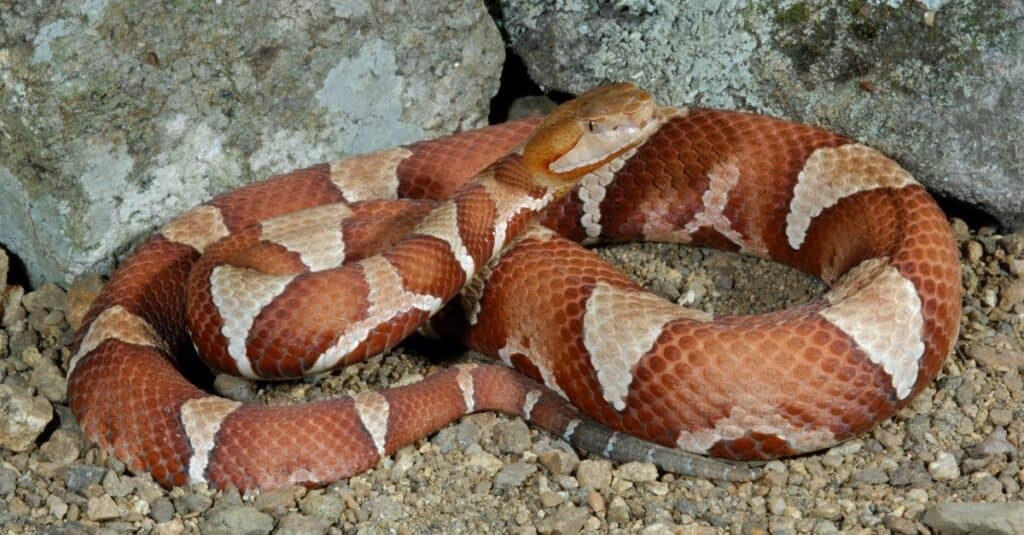
Copperhead snakes aren’t aggressive, but they are venomous.
©Breck P. Kent/Shutterstock.com
Named for the copper-bronze color of their heads, copperheads are common in the eastern half of the U.S. Copperheads average two to three feet long and love climbing trees after cicadas, but they also eat mice and small rats. Their hourglass markings often look like chocolate kisses when viewed from the side and their base color varies from light gray to pinkish brown.
This species is quite happy to live near homes and on the outskirts of small towns. Fortunately, copperheads aren’t aggressive. However, like most pit vipers, they don’t move out of the way quickly, so you need to give it more time.
Although they are venomous, their venom isn’t considered as dangerous as that of most rattlesnakes and other pit vipers.
Cottonmouth (Agkistrodon piscivorus)
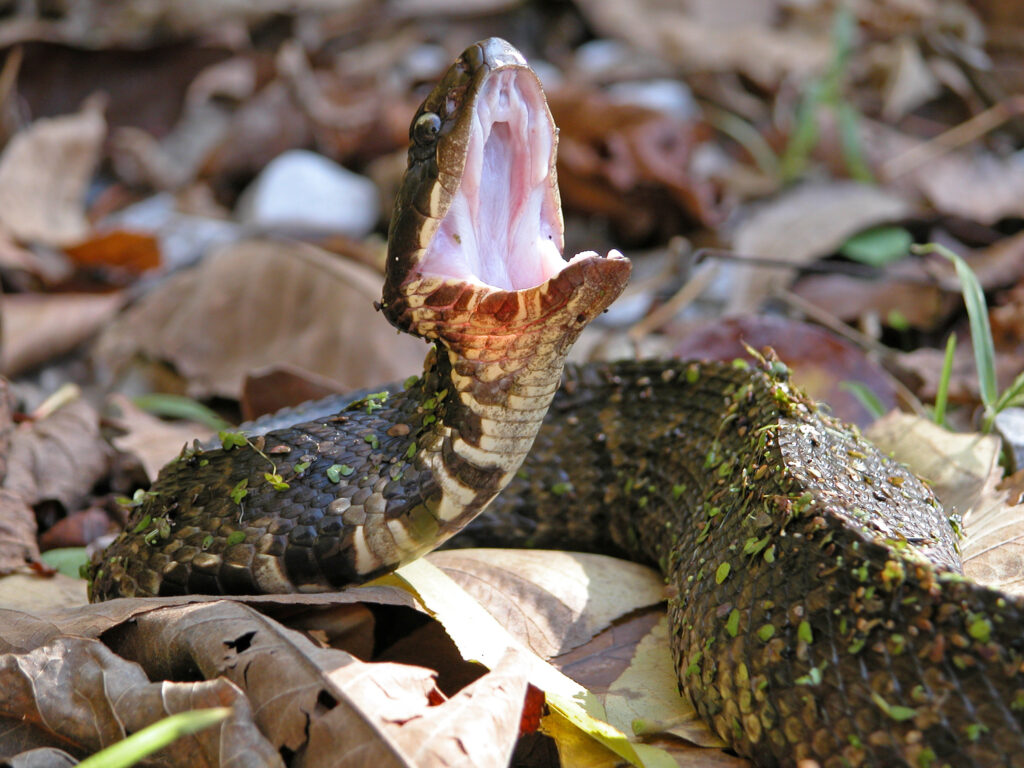
The cottonmouth will show off its fangs if it feels threatened.
©iStock.com/Gerald DeBoer
Also called water moccasins, cottonmouths get their name because their mouths are cotton-white inside. We see inside their mouths every time they feel threatened.
Because they don’t move fast (unless striking), a quick escape isn’t much of an option. Instead, they throw their mouths wide open and show off their fangs. However, they’re not going to chase you. Yes, we know there are stories — but they’re just stories.
These snakes are the only semiaquatic viper in North America and move gracefully through the water. Their diet consists primarily of fish, frogs, and small mammals.
Cottonmouths are fairly large and can reach five feet long, but most stay smaller. Juveniles have similar markings as copperheads, leading to many misidentifications. However, where copperheads keep their pattern throughout their lives, cottonmouths become dark brown, black, or greenish-black.
Like the other pit vipers in Illinois, cottonmouths are rare. You’ll only see them in the southern corner of the state.
The photo featured at the top of this post is © K Quinn Ferris/Shutterstock.com
Discover the "Monster" Snake 5X Bigger than an Anaconda
Every day A-Z Animals sends out some of the most incredible facts in the world from our free newsletter. Want to discover the 10 most beautiful snakes in the world, a "snake island" where you're never more than 3 feet from danger, or a "monster" snake 5X larger than an anaconda? Then sign up right now and you'll start receiving our daily newsletter absolutely free.
Thank you for reading! Have some feedback for us? Contact the AZ Animals editorial team.







